ASU Shaufler Prize in Journalism Call for Submissions
The prize is awarded to the best journalism in the country that advances the understanding of stories and…
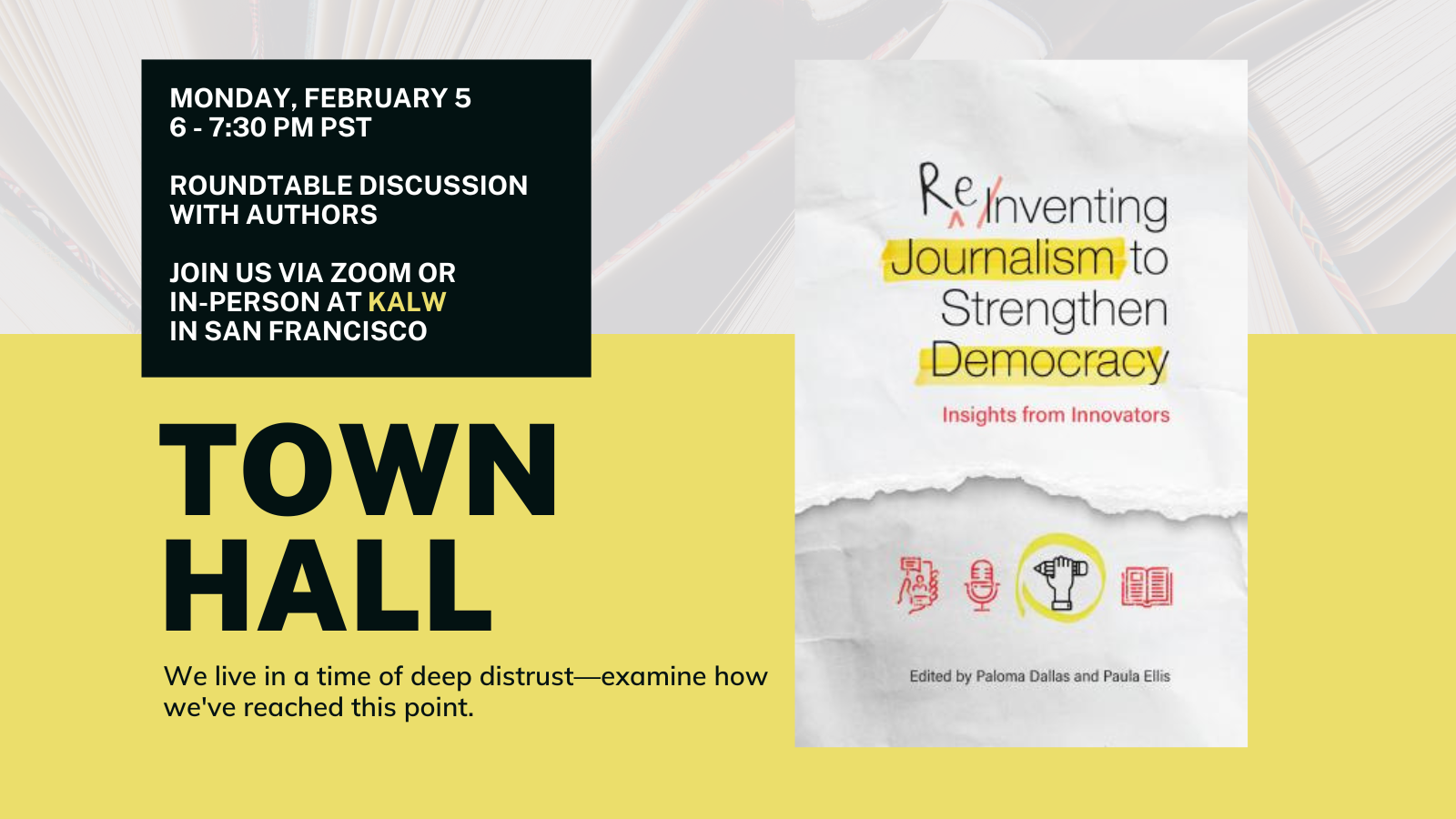
In 2023, the Kettering Foundation published a volume of essays on growing distrust of news media and opportunties for new practices to engage a diverse audience. Journalists from newspapers, public radio, civic media groups, and new media collectives contributed essays with their perspectives on how reinventing journalism as we know it can strengthen democracy. On February 5, 2024, KALW Public Media will host a free Town Hall, co-sponsored by the Society of Professional Journalists and the Kettering Foundation, featuring some of the authors, including Maynard Institute Co-Executive Director, Martin G. Reynolds. This blog includes an excerpt from his essay, titled “Dismantling Systemic Racism in News.”
From the publisher: During summer 2020, the killings of George Floyd and Breonna Taylor sent shockwaves across America. Newsrooms and the journalists in them also felt the shock. Martin Reynolds, former managing editor and editor in chief of the Oakland Tribune and co-executive director of the Robert C. Maynard Institute for Journalism Education, was one of them. Even though Reynolds saw himself “in Floyd, in Taylor, and in the faces of countless other people of color who had been slain by police,” his initial instinct was to maintain his objectivity and to frame these events through the lens of a media professional and not a Black man with a Black son. Reynolds examines this experience and suggests some ways the dismantling of systemic racism in newsrooms might begin.
The following is an excerpt from Reinventing Journalism to Strengthen Democracy: Insights from Innovators, published by the Kettering Foundation in 2023 and edited by Paloma Dallas and Paula Ellis. With persmission, we are sharing an edited excerpt from the essay, “Dismantling Systemic Racism in News,” written by Maynard Institute for Journalism Education’s co-executive director Martin Reynolds.
It feels difficult at this moment to return to the summer of George Floyd’s killing. I remember sitting in my car, rewatching the video on my phone, listening to accounts of protests. Hearing about Breonna Taylor and the list of other Black men and women and people of color killed by police was overwhelming.
I was enraged.
I was distraught.
I was scared.
I was ready to fight back.
How best to do that?
I decided I would never allow a police officer to press the life out of me. Trust in following police commands had been broken in a way I hadn’t before experienced. There was something about that time that felt profoundly different from other instances of police violence that I had helped cover or witnessed during my journalism career.
This time, tears of rage streamed down my face as I sat in my car.
Something snapped me out of a state of the journalistic objectivity that had guided my view of these stories and tragedies throughout my years as a journalist. This felt different and I could no longer separate my own Blackness and humanity from Floyd and from Taylor, slain in her own apartment by police following a no-knock warrant that was not issued for her.
For those reading this who aren’t journalists and who must be bewildered at how such separation from tragedy can be navigated, I must explain that I, among so many of my colleagues, was schooled in the objective approach to journalism.
I was taught that you kept your views on these issues from entering the coverage of a story, agreeing to a certain kind of internal invisibility. You are the witness, not the participant. You are the storyteller, not a character in the story.
I was instructed that who you are and what you have experienced have no place in the framing of a piece. You articulate what happened, with context of course. But often straight news stories about an incident weren’t the place for nuance and deep historical context. In the world of daily newspaper journalism where I was forging a career, you had to keep it moving.
“You can always do a folo (the journalistic term for a next-day story),” one of my former editors would say as she pounded out succinct edits on deadline.
News always happened the next day, so you moved on to the next homicide, fire, robbery, or carjacking. Or, perhaps the bit of context you did insert was removed or challenged by an editor or cut by the copy desk for space or because an editor thought it wasn’t appropriate.
I realize now that the invisibility extended beyond the role of journalist to a deeper place. I had to embrace the invisibility to survive, to find my place, to belong. But it wasn’t a true belonging.
Early in my career, I felt I had to compress elements of my identity and learn to turn away from the experiences that shaped my perception of the world. It wasn’t something that anyone necessarily said. It was more subtle and yet profound.
As that summer of violence and protest was unfolding, my initial instinct was to maintain my objectivity and to frame my view of these horrible events through the lens of a media professional and not a Black man with his own Black son.
Countless cases of Black and Brown people slain by police over the years hadn’t shaken that training, even though I felt pain each time it happened. The blatant racism on the part of police was something I had experienced many times, particularly as a young man, and I always felt as though it eroded my belief in democratic institutions.
The conflict of being a taxpayer and feeling under threat is a paradox I was never surprised by. I was taught that you kept your views on these issues from entering the coverage of a story, agreeing to a certain kind of internal invisibility.
And as news outlets scrambled to cover Floyd’s killing, something clearly snapped within them. The people who had so often been invisible were demanding to be seen. The reckoning in the streets, where we heard calls for racial justice, were echoed in newsrooms.
And there is a damn good reason for that. Fairly recently, newspapers, including the Orlando Sentinel, Los Angeles Times, Kansas City Star, Baltimore Sun, and the Philadelphia Inquirer, have, in various ways, admitted and apologized for their histories of racist coverage and the inflaming of racial tensions.
In a compelling Poynter Institute series, Mark I. Pinsky, author and former staff writer for the Orlando Sentinel wrote:
In recent years, a handful of the region’s newspapers have stepped forward to accept responsibility for biased reporting and editorials, shouldering their share of the burden of racist Southern history. They are acknowledging—belatedly—what their forebearers did and did not do in covering racism, White supremacy, terror and segregation over the past 150 years. Some newspapers, including the Sentinel, had especially grievous sins to confess.
The Inquirer’s look into its history, which was done by Pulitzer Prize-winning journalist Wesley Lowery, also apologized for the harm it had caused to Black journalists who worked for the paper, in addition to the Black community.
“The journalistic examination of the Inquirer by Wesley Lowery published this week [February 2022] puts our failings in brutal relief,” wrote Elizabeth H. Hughes, the paper’s publisher. “The reporting shows not only that we have not done right—it reveals, starkly, that we have done wrong. Black voices in the story—inside and outside the newsroom—articulate forcefully the harm we have inflicted over decades.”
As I reflect on this, now that some time has passed since the summer of Floyd and Taylor (which was followed by an insurrection fomented by a sitting president), I will say that my faith in democratic institutions does not have the luxury of being eroded by individuals not worthy of serving in them.
Looking at how representatives in the Trump administration, Congress, and even the spouse of a Supreme Court justice have behaved and perpetuated lies they know to be untrue has in some strange way evolved my view of the importance of these flawed but vital institutions.
Either the institutions themselves must be dismantled and rebuilt from the ground up or individuals with honor and integrity must stand up and lean against the pillars of these institutions and offer support to their cracking foundations.
I must admit that I am not sure which of these makes the most sense, or if either makes any sense.
The questions for me remain, What will be the true impact of these apologies? You can’t change an institution if the majority of the people inside it are unable, unwilling, or don’t know how, to unwind decades of socialized racism and bias. It is that racism and bias that have left so many feeling invisible, like they don’t belong in the very profession they have worked so hard to join.
I have to admit I never expected to “belong” in my newsroom. I was taught to endure, by journalists of color who were older and wiser. There wasn’t anything close to the refreshing expectation of “cultural competence” on the part of the institution that some younger millennials and Gen Zs have now come to call for.
I am glad they are, but that was not the reality I stepped into. The preparation I received was in the form of encouragement to sustain; to expect the arrows, the lack of cultural humility, blatant ignorance, and tone deafness; and to push through it in service of my career and
the need for more journalists of color in the newsroom.
We were prepared by journalists of color who were boomers and who were shaped by the experiences of their times and who were steeped in the civil rights movement. I was taught to understand that, in many ways, my presence was a form of protest.
The prize is awarded to the best journalism in the country that advances the understanding of stories and…
Read the letter from the Asian American Journalists Association, the Indigenous Journalists Association, the National Association of Black…
The Maynard Institute Co-Executive Director Martin G. Reynolds is one of the essayists featured in the new book…

Arizona State University’s Walter Cronkite School of Journalism and Mass Communication is calling for submissions for the Shaufler Prize in Journalism. Now in its third year, the prize is awarded to the best journalism in the country that advances the understanding of stories and issues related to underserved people in society. This can include communities of color, the LGBTQIA+ community, immigrants, the disabled community, and more. The deadline to enter is December 6, 2023. There is no entrance fee, and winners will be announced in early 2024.
With great storytelling in a print, digital, audio or television platform, the best entry by a student could receive a $5,000 prize. In the professional category, the awards are $10,000 for first prize, $3,000 for second place, and $2,000 for third place.
The Shaufler Prize was established by Paul B. Anderson, the principal & CEO of Workhouse Media in Seattle, Washington to honor his late friend, Ed Shaufler, who died in late 2020. Shaufler cared deeply about promoting understanding of underrepresented people. The prize recognizes America’s best journalism advancing the understanding of stories and issues related to underserved people in society, such as communities of color, immigrants and LGBTQ+.
In previous years, the winning entries have focused on environmental racism, the life and murder of George Floyd and more. Momo Chang, the Maynard Institute’s Oakland Voices Co-Director, participated on the panel of judges for the 2nd annual prize. Winners in the professional and student categories were honored in an awards ceremony at the Cronkite School. Read more about past winners.
Read an excerpt of the essay written by the Maynard Institute's Co-Executive Director, Martin G. Reynolds, for the…
Read the letter from the Asian American Journalists Association, the Indigenous Journalists Association, the National Association of Black…
The Maynard Institute Co-Executive Director Martin G. Reynolds is one of the essayists featured in the new book…
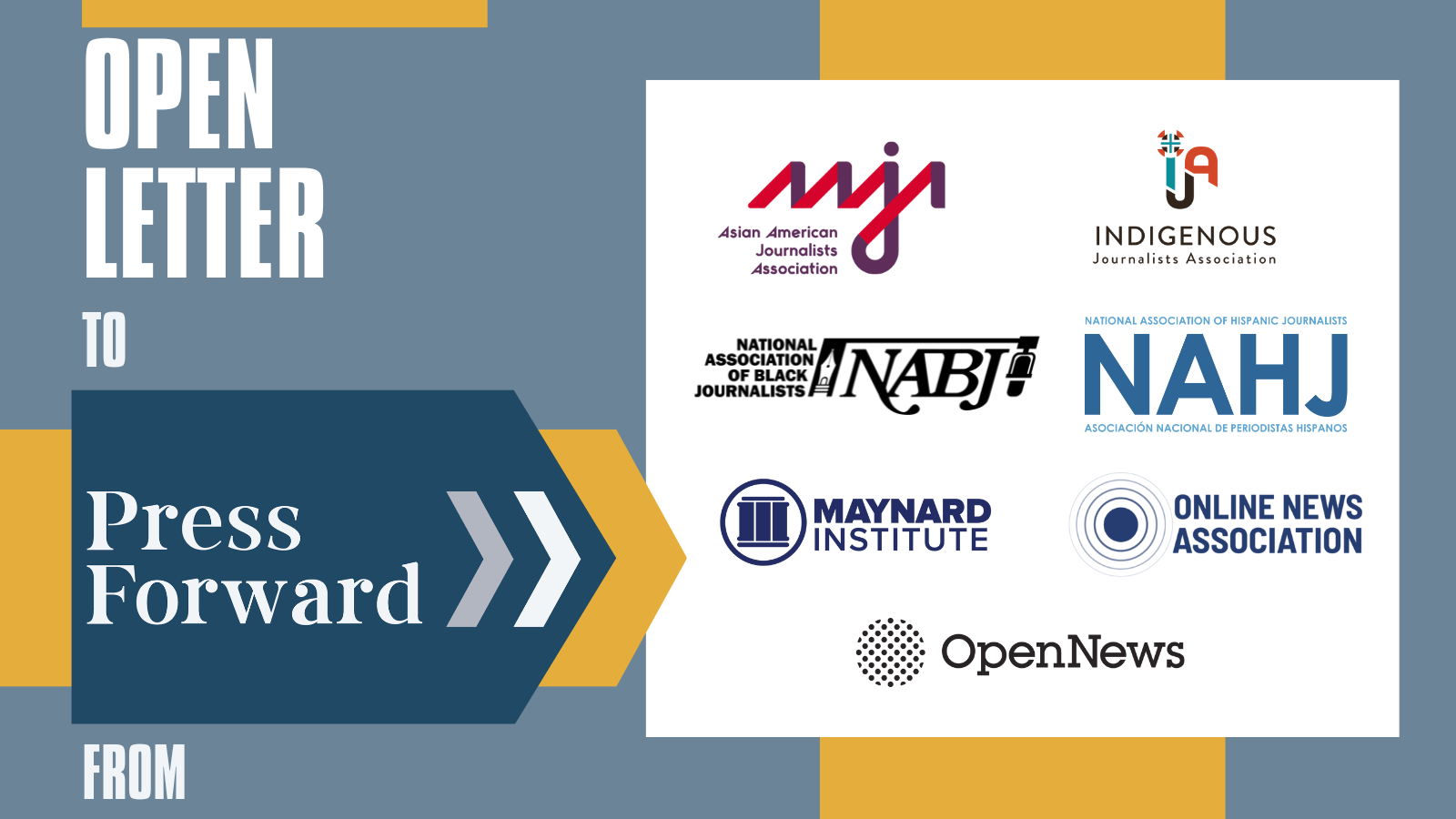
For a print-friendly version of the open letter access the PDF file format.
For those of us who work in journalism, there is not a day that passes that we don’t see vividly how newsrooms are shrinking and how local news deserts are negatively impacting people.
So when a group of foundation leaders and heads of philanthropic organizations announced the Press Forward initiative to raise hundreds of millions of dollars to support local news, those of us who work in the field didn’t hesitate to applaud. After all, we need many more funders to understand that local news is vital to the health and sustainability of our democracy. A growing number of people are vulnerable to becoming victims of disinformation and misinformation masquerading as credible local and national news.
As the much-anticipated initiative to fortify local news ecosystems rolls out, we think it’s important to remember just what is “local news” and who are the people who have long been providing it.
The organizations that have signed this open letter represent, support, train and serve many of the journalists, leaders and founders of color who are essential to the sustainability of healthy, equitable and trustworthy local news ecosystems.
Philanthropy has a responsibility to be inclusive, intentional and transparent about how funding from this initiative is distributed. It is no secret that BIPOC-led organizations are awarded less grant money and are less trusted with how to spend that money when compared to white-led institutions. A recent Lenfest Institute/National Trust for Local News study of 103 publishers of color and outlets serving “racial, ethnic, or linguistic communities” revealed that 53 percent of them will be out of business in less than five years if current revenue trends persist.” In effect, that would undermine the stated objectives of the Press Forward initiative.
Our organizations have come together to advocate on behalf of Asian, Black, Hispanic, Indigenous and other people of color who have historically been neglected, misrepresented or tokenized. Engaging our people and our communities in Press Forward will be vital to its success and credibility. In many of the country’s most populous regions and cities, communities of color account for the majority demographic.
We are pleased to see that the funding priorities of the Press Forward initiative include “improving diversity of experience and thought.” As this initiative unfolds and decisions are made about where support is directed, we want to be clear: Racial and ethnic diversity, equity and belonging must be among the pillars of its foundation. An equitable distribution of resources and opportunities ensures that underrepresented voices are heard and elevated by journalists, leaders and publishers who know them best.
What we mean by this is:
Racial and ethnic diversity fosters trust between media outlets and underrepresented communities. When people see themselves and their experiences reflected in the news, they are more likely to engage with it and view journalism as a credible and valuable resource. We know from research done by the Trust Project that one of the indicators of trustworthiness on the part of news consumers is the inclusion of diverse voices.
If philanthropy is not intentional about addressing historical funding inequities and the processes by which they persist, it is complicit in the harm they inflict. At a time when we are seeing intentional and structural attacks on marginalized communities gain momentum in our society, this would be unacceptable.
Significant investment in the people, publications, and organizations that serve an increasingly diverse society must be made with clear-eyed intention. We commend the support many of the foundations that are part of this initiative have contributed to news ecosystems. We stand ready to help this effort any way we can; we are watching it with enthusiasm, with vigilance and concern.
As philanthropic stakeholders dedicated to supporting the growth and sustainability of local news, your commitment to these values can help shape not only the future of journalism, but also the broader fabric of our society.
Thank you.
Signed,
For media inquiries: andrews@aaja.org, jmedina@naja.com, press@nabj.org, asherry@nahj.org, mreynolds@mije.org, karolle@journalists.org, info@opennews.org
Since joining with other journalism affinity organizations and sending this open letter to Press Forward, our collective efforts to ensure equity in news funding have been covered in journalism industry news across a multitude of platforms.
For more than 45 years, the Maynard Institute has fought to push back against the systemic lack of diversity in the news industry through training, collaborations and convenings. Founded by Robert C. Maynard, the Institute promotes diversity and antiracism in the news media through improved coverage, hiring and business practices. We are creating better representation in U.S. newsrooms through our programs , which gives media professionals of color the tools to become skilled storytellers, empowered executives and inspired entrepreneurs. Donate to support our programs.
Read an excerpt of the essay written by the Maynard Institute's Co-Executive Director, Martin G. Reynolds, for the…
The prize is awarded to the best journalism in the country that advances the understanding of stories and…
The Maynard Institute Co-Executive Director Martin G. Reynolds is one of the essayists featured in the new book…
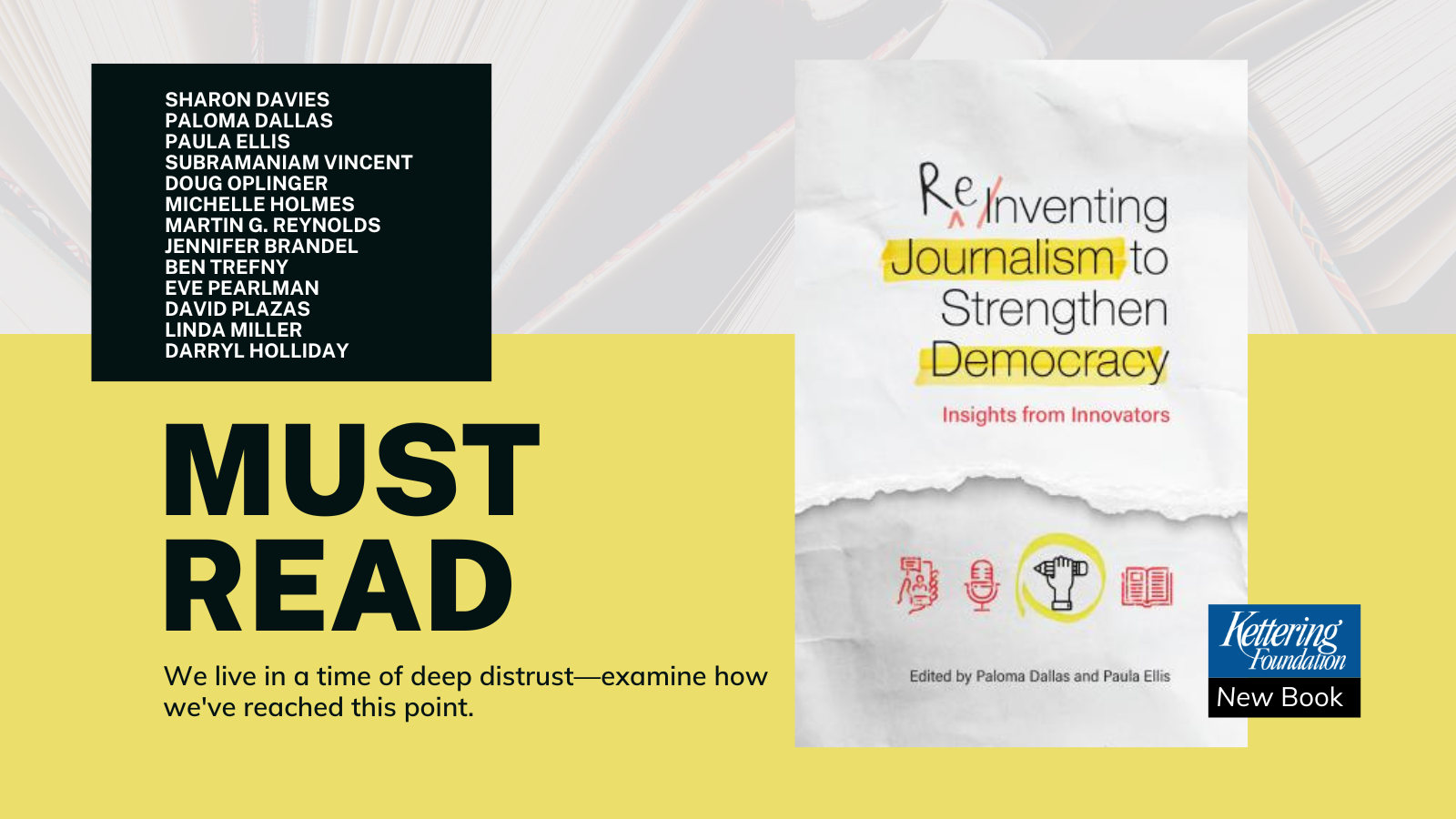
NEW BOOK RELEASE — From the Kettering Foundation website: We live in a time of deep distrust―of each other, the media, and institutions of all kinds. In this volume of essays, innovative journalists from newspapers, public radio, civic media groups, and new media collectives examine how we’ve reached this point. The loss of newspapers and fracturing of the information ecosystem have weakened our sense of a shared identity, but many people have long felt excluded, misrepresented, and unable to see themselves and their experiences reflected in news reporting. These essays highlight opportunities that are emerging as old practices give way to the new demands of an engaged, diverse, and restive public. They call on us to create a more inclusive democratic narrative that better captures the rich diversity of our nation and its complicated history.
Martin G. Reynolds, “Dismantling Systemic Racism in News”
During the summer of 2020, the killings of George Floyd and Breonna Taylor sent shockwaves across America. Newsrooms and the journalists in them also felt the shock. Martin Reynolds, former managing editor and editor in chief of the Oakland Tribune and co-executive director of the Robert C. Maynard Institute for Journalism Education, was one of them. Even though he saw himself “in Floyd, in Taylor, and in the faces of countless other people of color who had been slain by police,” his initial instinct was to maintain his objectivity and to frame these events through the lens of a media professional and not a Black man with a Black son. Reynolds examines this experience and suggests some ways the dismantling of systemic racism in newsrooms might begin.
Read more about the other essays on the Kettering Foundation website and get your copy today!
Read an excerpt of the essay written by the Maynard Institute's Co-Executive Director, Martin G. Reynolds, for the…
The prize is awarded to the best journalism in the country that advances the understanding of stories and…
Read the letter from the Asian American Journalists Association, the Indigenous Journalists Association, the National Association of Black…

FOR IMMEDIATE RELEASE — Oakland, Calif. (February 17, 2023): The Robert C. Maynard Institute for Journalism Education, a nonprofit dedicated to expanding diversity in the news media and dismantling structural racism in newsrooms, announced today the news organizations selected to participate in the Equity and Belonging Newsroom Transformation Program are The Gazette in Cedar Rapids, Iowa, and GBH News in Boston.
The pilot program, funded by the John S. and James L. Knight Foundation, pairs news organizations with consultants who have a wealth of experience training journalists on diversity, equity, inclusion and belonging (DEIB) issues. The goal is to help transform workplace structures, organizational cultures and news coverage to be more inclusive and reflective of the United States.
“With this pilot, we’re trying to see if we can operationalize the concept of belonging,” said Martin G. Reynolds, co-executive director of the Maynard Institute. “This is very challenging work because it requires an individual and collective unwinding of internalized biases and perceptions that have made news organizations toxic places for so many, particularly people of color. We see this work as a journey. What’s exciting about working with The Gazette and GBH News is that each organization is starting at a different place along this journey and we are excited to work with our consulting teams to help them make significant progress.”
Celebrating its 140th year in continuous operation, The Gazette is an employee-owned newspaper with 30,000 daily subscribers. Based in Cedar Rapids, the second-largest city in the state of Iowa with a population of 138,000 residents, The Gazette also covers Iowa City, which is home to the University of Iowa. The communities range from a mix of industrial employees and a sizable refugee population from Sudan.
“We are focused on local enterprise news that looks to solutions rather than just pointing out problems,” said Zack Kucharski, executive editor and employee owner of The Gazette. “We know that we can improve in representation on the staff and in coverage practices to best reflect the diversity of our community, while also working to give these populations a voice and build trust.”
The Gazette, which has participated in previous diversity programs, applied to the Maynard Institute’s pilot program to gain momentum in order to transform their newsroom culture and business practices. As part of the pilot program’s embedded consultant model, The Gazette will be paired with a group of DEI experts based in Southern California, from CRB Global & Rich Diversity Consulting.
“We are excited to take a team-wide approach, as there are challenges across many of the topical areas that we cover, and we need everyone thinking about this,” Kucharski said.
“Working to build norms and benchmarks and have consistent practices will also allow us to measure progress, and that’s an important piece of making this part of the culture of the organization,” he said.
Similarly, GBH News is invested in sustained cultural change. Located in Boston, GBH is the leading multiplatform creator for public media in the United States as the largest producer of content for PBS and partner to NPR and PRX. The vision of GBH News, which reaches more than 400,000 people weekly across all platforms, is to transform into one cohesive, audience-focused news organization by creating an anti-racist, radically inclusive and culturally responsive newsroom without walls to better serve an increasingly diverse and curious population. A team of DEI consultants who represent Global Equity Collective will help GBH News work toward that goal.
“We re-envisioned our beat structure to create distinct local stories of the day in collaboration with a wider audience,” said Lee Hill, executive editor for GBH News. “By 2027, our newsroom will closely mirror the city of Boston, which is rapidly changing demographically. Internally, we have to ensure that we are culturally responsive. We created two working groups focused on equitable professional development and belonging.
“In 2022, GBH News began a mandatory Source Diversity Survey,” Hill said. “As part of this, our journalists ask each person we interview questions about their race, gender, age, location to ensure that GBH News becomes more infused and informed by the diverse communities we serve.”
Felecia D. Henderson, director of cultural competency at the Maynard Institute, said the Equity and Belonging Newsroom Transformation Program will provide an opportunity to meet each news organization where they are in their current cultural journey and lead them toward sustainable, equitable change.
“We are excited to partner with The Gazette and GBH News to give them the tools that will have lasting impact inside their organizations and with their communities,” Henderson said.
For 45 years, the Maynard Institute has fought to push back against the systemic lack of diversity in the news industry through training, collaborations and convenings. Founded by Robert C. Maynard, the Institute promotes diversity and antiracism in the news media through improved coverage, hiring and business practices. We are creating better representation in U.S. newsrooms through our programs , which gives media professionals of color the tools to become skilled storytellers, empowered executives and inspired entrepreneurs. Visit the Maynard Institute website to learn more.
CONTACT:
Felecia D. Henderson
Director of Cultural Competency, Maynard Institute
fhenderson@mije.org
Martin G. Reynolds
Co-Executive Director, Maynard Institute
mreynolds@mije.org
Read the press release on PRWeb.
Read an excerpt of the essay written by the Maynard Institute's Co-Executive Director, Martin G. Reynolds, for the…
The prize is awarded to the best journalism in the country that advances the understanding of stories and…
Read the letter from the Asian American Journalists Association, the Indigenous Journalists Association, the National Association of Black…

Is your news organization ready to establish a more equitable workplace and provide better coverage of underserved communities? Subscribe for email updates about our next program application period.
What makes this program unique? The Equity & Belonging Newsroom Transformation Program leverages an embedded coaching model to help news organizations better inform underserved communities and establish workplace cultures of belonging. Our goal is to help newsrooms become more equitable and inclusive in their reporting, workplace, and in the communities they serve. The team of consultants piloting the program curriculum will work closely with Maynard Institute facilitators who are steeped in the Fault Lines® training methodology. As the extended application deadline approaches on October 14, we asked the program’s consultants why they think organizations should apply. Read their bios to learn more about their expertise and check out their quotes below.
“Too often diversity efforts are performative. We want to operationalize belonging so that BIPOC and folks of diverse backgrounds can thrive and contribute even more meaningfully to the growth, sustainability and credibility of the outlets where they work. We want to show that when organizations invest in equity and inclusion, working relationships between people improve, there is less labor strife, attrition and toxicity. Newsrooms that center the concept of belonging foster innovation, better journalism, and more importantly, the capacity to build or repair relationships with communities. We are excited to see what we can create through this program.”
Martin G. Reynolds, Co-Executive Director of the Maynard Institute
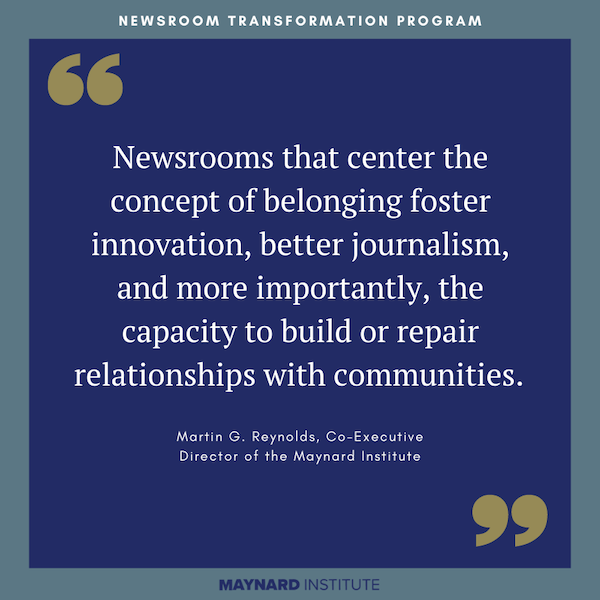
“Newsrooms face multiple levels of revolution internally and externally: from changing community and newsroom demographics and social and political tensions, to differing generational expectations about inclusion, work and journalism ethics. This program offers the opportunity to examine your dynamics, learn about who you are, how you work together and what your impact has been and could be on each other and in your communities. This holistic, in-depth approach aspires to help journalists of today face complex challenges with empowering insight and tools.”
Mei-Ling Hopgood, Maynard Institute program researcher and Professor at the Medill School of Journalism, Media, Integrated Marketing Communication at Northwestern University
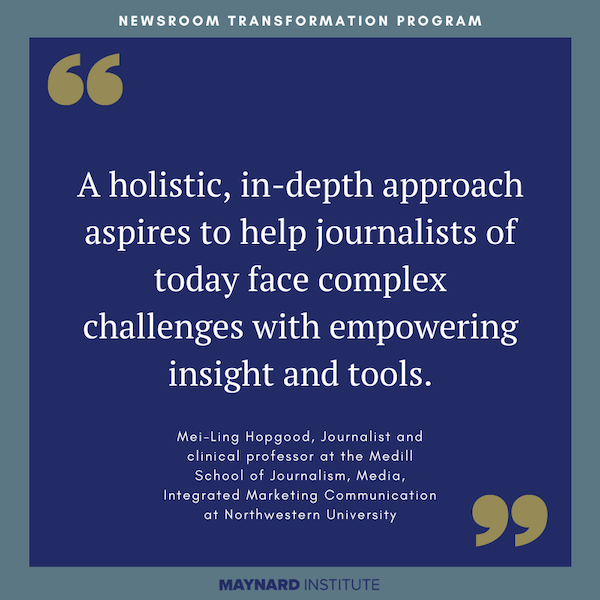
“Newsrooms are feeling the pressure and urgency when it comes to understanding and implementing best practices surrounding DEI. We are excited to support organizations as they grow in their knowledge and implement sustainable, long term investments towards strengthening the equity and inclusion in their respective newsrooms.”
Kate Sultuska, Global Equity Collective
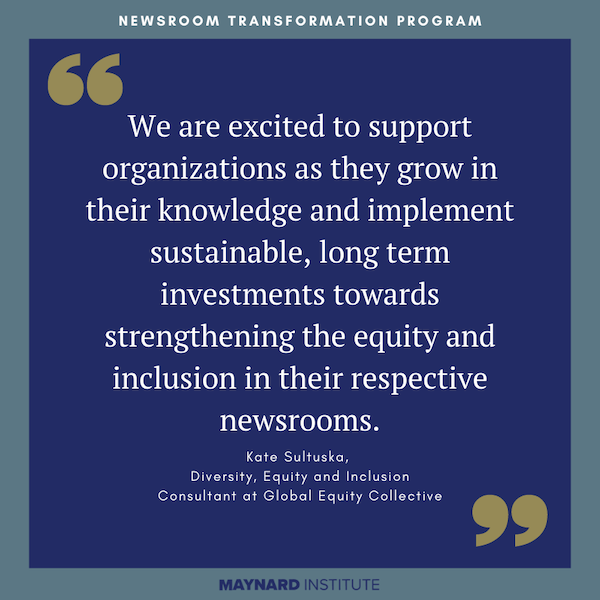
“What would it mean for your news organization to be deeply understood and deeply challenged to grow in its diversity goals? Our mission is to partner with you in that process through the Newsroom Transformation Program program. Our team holds expert credentials in journalism, law, professional leadership, counseling, management, social policy, and advanced DEIB training. This background makes us uniquely positioned to understand your newsroom’s internal DEIB challenges and opportunities, as well as the essential community connections and impacts a newsroom must negotiate in today’s world. DEIB has an important role to play in your institution’s news voice and identity, and we promise to be a collaborative guide on that journey.”
Carol Ross-Burnett, CRB LLC
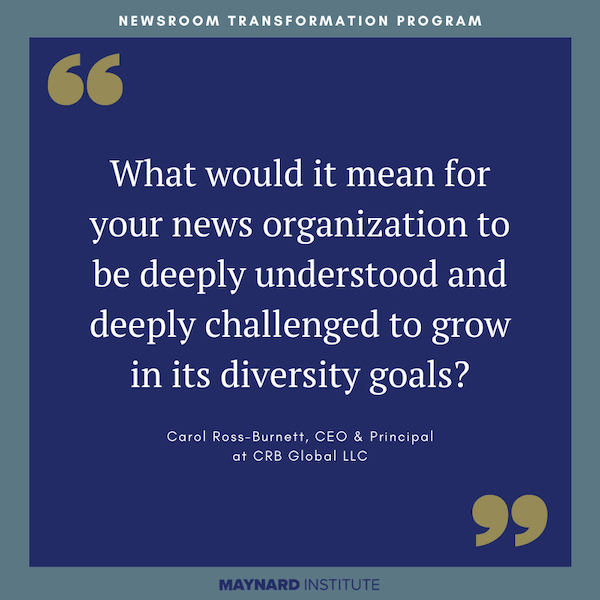
“There’s never been a more urgent time for newsrooms to grapple with inequity in their own businesses and in society. We are proud to be part of this important initiative.”
Anasstassia Baichorova, Global Equity Collective
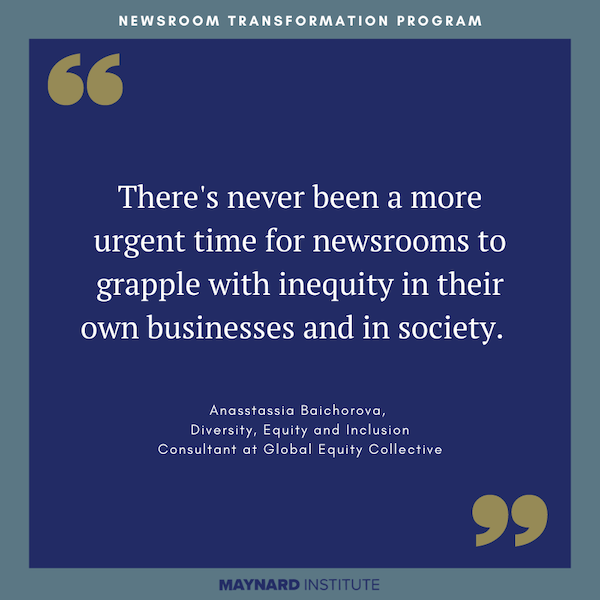
“This initiative presents a great opportunity to bring experts in the field together to lead two news organizations toward sustainable, equitable change. Our goal is to test methodologies, re-test, and document the processes of both pilot programs in order to replicate the work to assist future media outlets that want to make meaningful change.”
Felecia D. Henderson, Director of Cultural Competency at the Maynard Institute
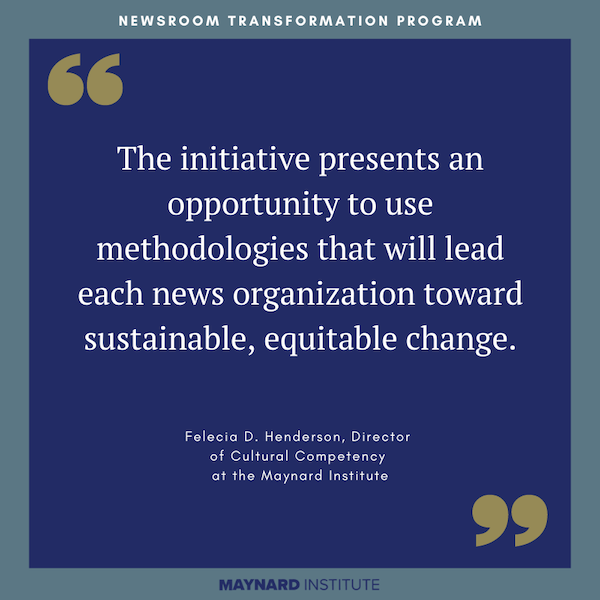
The Newsroom Transformation Program will provide two news organizations with the opportunity to develop the tools needed to implement a sense of belonging and equity in the newsroom. The goal is to create a professional learning experience that will benefit a media outlet. The Maynard Institute wants to help contribute to best practices in community journalism and to the implementation of the Fault Lines® framework.
APPLICATIONS ARE NOW CLOSED. Application responses will be used to determine your training needs and how the training can build upon your existing knowledge, skills, and experiences. Learn more.
Read an excerpt of the essay written by the Maynard Institute's Co-Executive Director, Martin G. Reynolds, for the…
The prize is awarded to the best journalism in the country that advances the understanding of stories and…
Read the letter from the Asian American Journalists Association, the Indigenous Journalists Association, the National Association of Black…
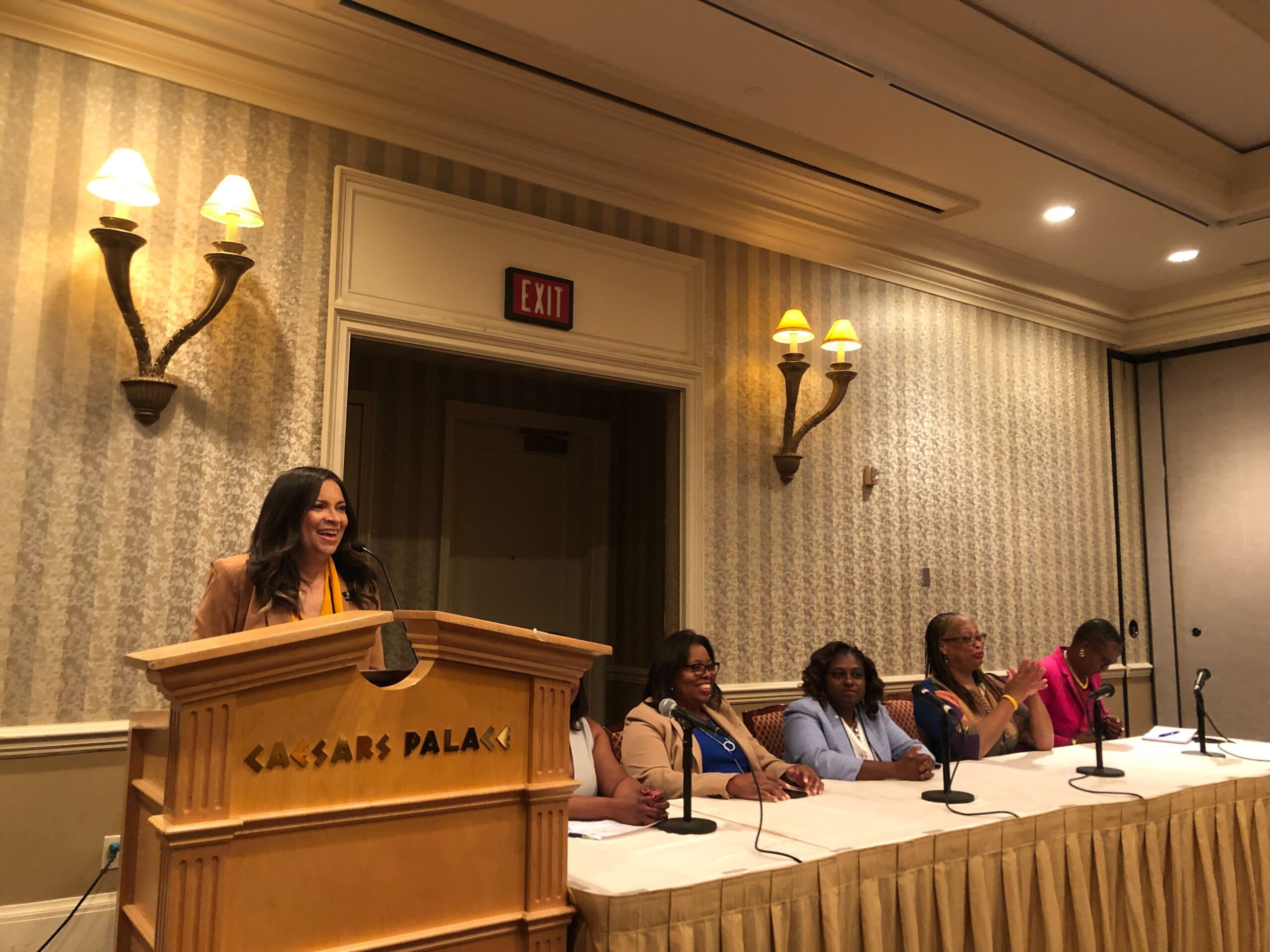
The Maynard Institute was fortunate enough to present two in-person events at this year’s NABJ-NAHJ Convention in Las Vegas. In addition to a cocktail reception celebrating the institute’s 45th anniversary, Felecia Henderson, an award-winning newspaper editor and Director of Cultural Competency at the Maynard Institute, organized and moderated a panel discussion titled, ‘The New Face of Executive Leadership: Black Women Smash Print Industry’s Glass Ceiling.’ This blog details some highlights and key takeaways from the standing-room only session.
Last year proved to be history-making for Black journalists in positions of power. In 2021, six women were tapped to lead print news organizations as executive editor, roles traditionally held by white men. They are charged with coverage, operational budgets, hiring, retention and the overall health and viability of their organizations. In a wide-ranging conversation, seven ground-breaking women shared their journeys, issues they face inside and outside their organizations, and what they are doing to ensure more journalists of color have opportunities to succeed.
Panelists included:
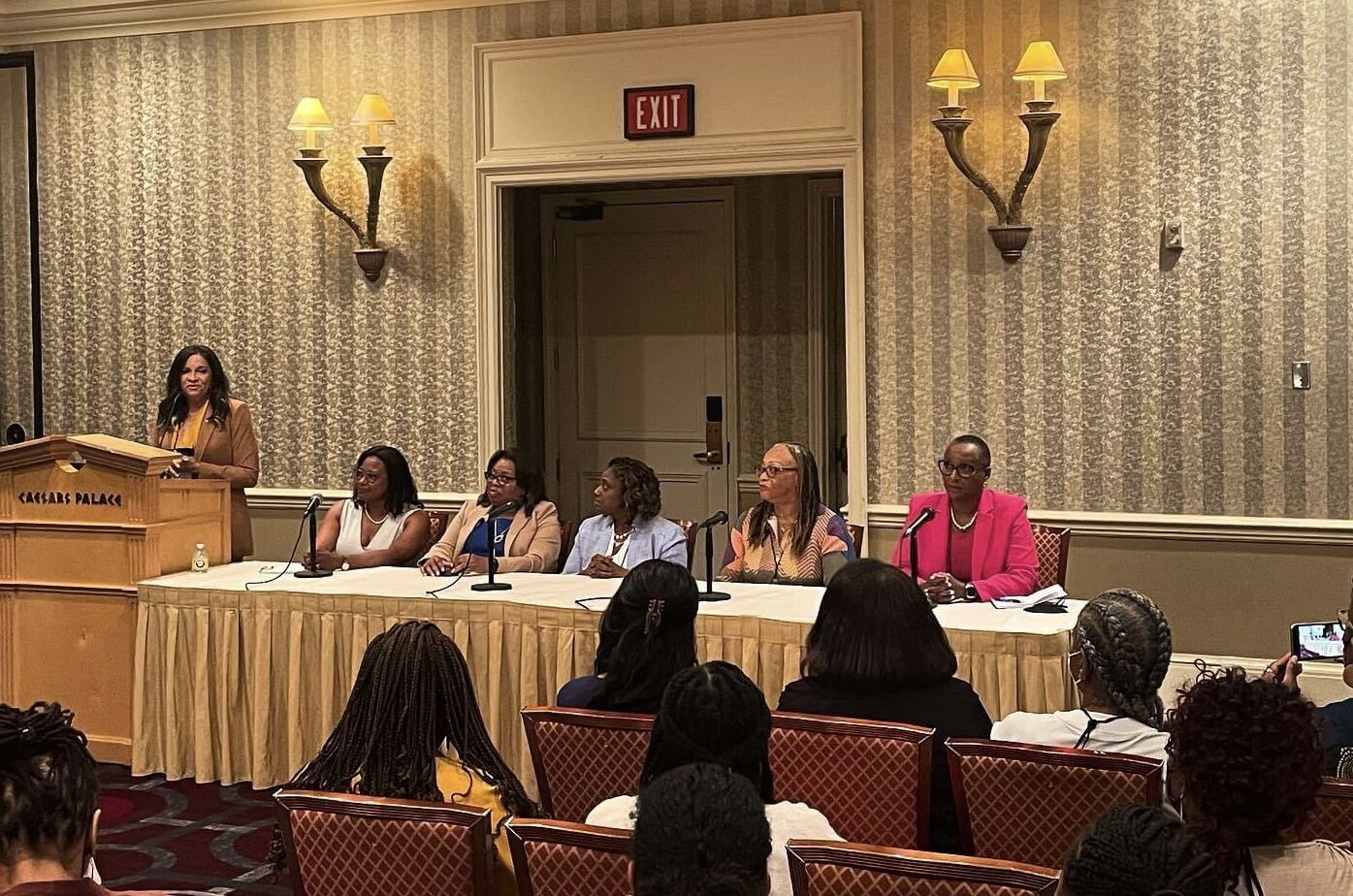
Photo by Mark Russell / The (Memphis) Commercial Appeal
In addition to her role as Director of Cultural Competency at the Maynard Institute, Henderson has served as a coach on Diversity, Equity, Inclusion and Belonging issues to more than 100 print and broadcast news organizations nationwide that participate in Table Stakes digital newsroom innovation programs. Prior to joining the institute, Felecia was Assistant Managing Editor at The Detroit News where she was a member of the senior management team responsible for newsroom operations. Henderson shared she was inspired to create the panel session for NABJ-NAHJ convention, in part, because of lack of attention to this key milestone.
“I conceived this discussion to shine a spotlight on the extremely talented, groundbreaking women who are leading print news organizations in 2022. There has been no full-scale story on this historic period in the journalism industry, and the women deserve recognition,” she said.
The ‘New Face of Executive Leadership’ session was designed to help participants take away strategies on earning or maintaining a seat at the leadership table. Key points ranged from addressing racist and sexist hate mail and social media vitriol, to tips for developing mentors and allies.
Henderson opened the session to a completely packed room. As attendees continued to stream in when there was standing-room only, she acknowledged that panelists Katrice Hardy and Mary Irby-Jones were forced to cancel their appearances at the convention.

Photo by Odette Alcazaren-Keeley
Henderson led with asking panelists about some of the positive experiences they have had as some of the first Black, female executives at their respective papers. Leisa Richardson of The State Journal-Register in Springfield, Ill., said, “I have had the opportunity to shape the careers of BIPOC journalists. Relaunching careers or starting young careers.”
As executive editors, the panelists also emphasized their ability to impact diverse hiring and fair reporting practices on communities of color at their organizations. “To be able to shape coverage and hold the door open and wait to fill a job until the applicant pool is diverse is critical,” said Reeve of the Houston Chronicle, “and it’s not something you see unless there are executives of color.”
Monica Richardson of the Miami Herald echoed the importance of holding space and nurturing journalists of color, saying that she feels joy when, “journalists come to me and say that they have never had anyone else to go to before.”
The audience reaction was palpable upon hearing about the panelists’ experiences with overt and covert racism. Richardson, who is the first Black executive editor in the history of the Miami Herald, shared her decision to publicly address a piece of particularly egregious hate mail. She was concerned with backlash. “You have to be fearless in order to stand up to hate and racism and to say that this is not ok,” she said.
When Henderson transitioned to hear audience questions, journalists of all generations shared their gratitude for the sacrifices made by the trailblazers.
Debra Adams Simmons, who also serves on the Maynard Institute board of directors, closed by praising the community that the group of panelists have forged. “We may have been some of the first, but we will not be the last.”
Shortly on the heels of the NABJ-NAHJ Convention, the Maynard Institute will be joining Online News Association conference in Los Angeles to continue our Vision25 Pay Equity series on Thursday, Sep 22 – 2:30 PM – 3:30 PM PT. This session is a follow-up to the August 11th webcast featuring guest speakers from Media2070. The Online News Association, OpenNews and the Maynard Institute have come together to create Vision25: Building Racial Equity in Newsrooms, a catalyst in a social change movement that seeks to build journalistic institutions where newsrooms are actively anti-racist and collaborative, and journalists of color feel like they truly belong. Learn more and register for the event.
Read an excerpt of the essay written by the Maynard Institute's Co-Executive Director, Martin G. Reynolds, for the…
The prize is awarded to the best journalism in the country that advances the understanding of stories and…
Read the letter from the Asian American Journalists Association, the Indigenous Journalists Association, the National Association of Black…
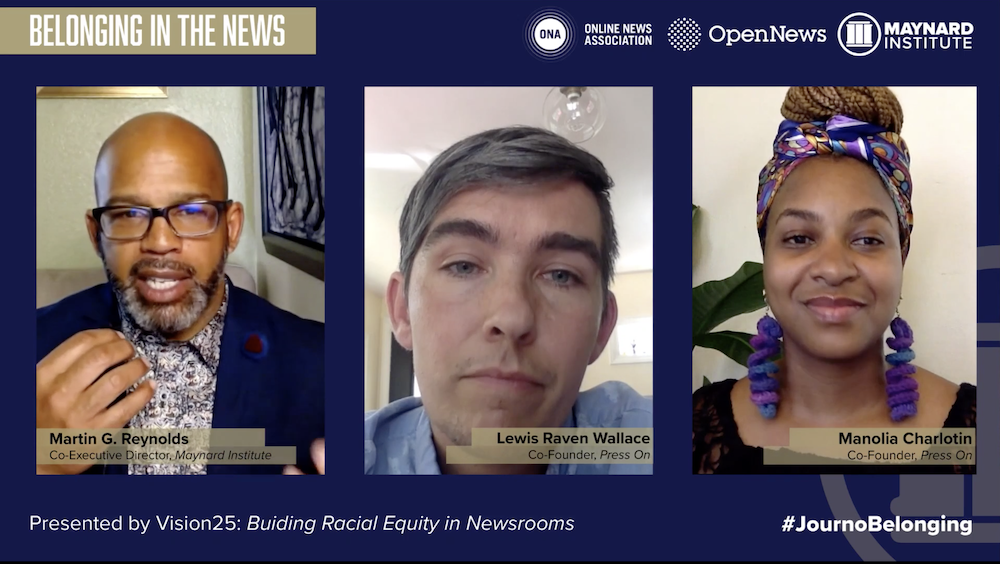
Martin G. Reynolds in conversation with Manolia Charlotin and Lewis Raven Wallace of Press On in episode four of Vision25 Belonging in the News
Vision25’s Belonging in the News returns next week with acclaimed journalist and editor-in-chief of Teen Vogue, Versha Sharma as our guest. Register for the next Belonging in the News discussion — we promise our guests don’t hold back! In honor of the 2022 return of our popular virtual event series in partnership with OpenNews and the Online News Association we’re sharing a compilation of some of our favorite mic drop moments from the past episodes.
One of the goals for the Vision25: Building Racial Equity in Newsrooms collaboration is to establish ‘institutions of belonging.’ The term describes actively anti-racist news organizations where journalists of color have a sense of agency and belonging in the newsroom. We believe that institutions of belonging are part of the solution to creating a diverse, equitable and trustworthy press.
1.“If our standard is to appear to be objective, our standard becomes to lie to our readers.”
These journalism institutions should have their values clearly stated somewhere. If truth-telling is a value then no journalist working for an institution should get in trouble for telling the truth.” –Episode 3, Wesley Lowery, Pulitzer Prize-winning journalist, author and correspondent for CBS News
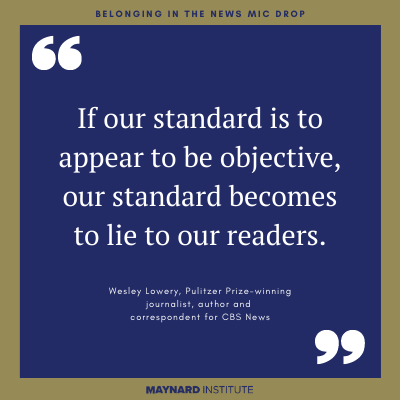
2.“We’re trusting heterosexual, white men of privilege who have been consuming mainstream narratives about immigrants for years to do ‘objective’ reporting on that issue and hire reporters on that issue… And all of the media we are consuming is through that filter. That is bad journalism.” –Episode 2, Maria Hinojosa, executive producer of Latino USA and creator of Futuro Media Group
3.“We[journalists] have been trained out of our humanity. When you are trained out of your humanity, you can’t see that you are taking a piece of someone’s respect and dignity by ‘objectifying’ them.” –Episode 4, Manolia Charlotin, Co-founder of PressOn

Martin G. Reynolds in conversation with Maria Hinojosa
4.“Journalists need to hold powerful people accountable–the powerful people within our own journalism institutions.” –Episode 4, Lewis Raven Wallace, Co-founder of PressOn
5.“Newsrooms today don’t reflect our communities, they reflect power.”
-Episode 1, Nikole Hannah-Jones, reporter for The New York Times Magazine and creator of the 1619 Project
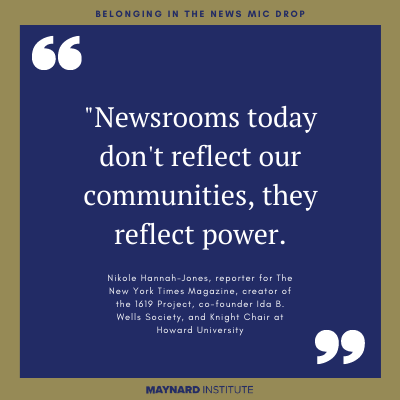
6.“Radical imagination is something that exists and that is alive and breathing as a practice in marginalized and oppressed communities, and the way they are going about change is to reimagine the systems they are impacted by.” –Episode 4, Manolia Charlotin, Co-founder of PressOn
7.“We’re seeking the white audience by not telling the truth about racism, and black people are going, ‘What is this nonsense?’” –Episode 3, Wesley Lowery, Pulitzer Prize-winning journalist, author and correspondent for CBS News
8.“The critic’s job is to help people understand what questions they should be asking; how to use food and restaurants to start a larger social conversation.” –Episode 5, Soleil Ho, Restaurant critic for the San Francisco Chronicle
9.“We [journalists] cannot compromise our values of truth and fairness to seek the validation of bad faith actors.” –Episode 3, Wesley Lowery, Pulitzer Prize-winning journalist, author and correspondent for CBS News

Martin G. Reynolds in conversation with Wesley Lowery.
10.“The sense of feeling you belong will make you a better journalist.” –Episode 2, Maria Hinojosa, executive producer of Latino USA and creator of Futuro Media Group
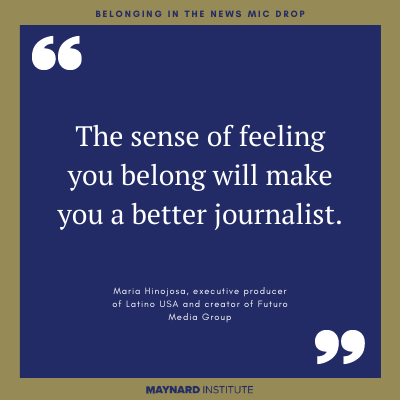
11.“The 1619 Project would not exist if I was not being treated as if I belonged in the newsroom. You have to treat me as an equal who is worth investing in.”
-Episode 1, Nikole Hannah-Jones, reporter for The New York Times Magazine and creator of the 1619 Project
12.“Hip hop taught me everything–it led me to writing about the fine arts, it led me to covering President Obama, and it led me to writing about resegregation. Hip hop’s the glasses I wear–I see everything through it.” –Episode 6, Jeff Chang, author, journalist and a senior advisor at Race Forward

In the April 2022 episode of Belonging in the News, co-executive director of the Maynard Institute Martin Reynolds, discussed belonging with award winning-journalist and the current editor-in-chief of Teen Vogue, Versha Sharma. Teen Vogue, a web-only Condé Nast publication, pivoted to become a strong voice on social justice issues in recent years. The discussion explored:
The event is one hour. The last 15 minutes was open for audience questions as part of a moderated, post-event party for members of the audience to flesh out any of the comments or themes from the live discussion. This post-event discussion was hosted by executive members of Vision25 in the chat on our Crowdcast livestream after the event ended. Watch the recording.
The Online News Association, OpenNews and the Maynard Institute have come together to create Vision25: Building Racial Equity in Newsrooms, a catalyst in a social change movement that seeks to build journalistic institutions where newsrooms are actively anti-racist and collaborative, and journalists of color feel like they truly belong. Learn more here.
Read an excerpt of the essay written by the Maynard Institute's Co-Executive Director, Martin G. Reynolds, for the…
The prize is awarded to the best journalism in the country that advances the understanding of stories and…
Read the letter from the Asian American Journalists Association, the Indigenous Journalists Association, the National Association of Black…

As the mystery of Gabby Petito’s whereabouts unfolded in 2021, news media clamored to cover the story. Partially chasing the clicks of the social media users who went viral trying to determine her whereabouts when Petito was announced missing, national and local news prioritized the story and especially when tragically, her remains were discovered. The Maynard Institute was contacted by the media outlets listed below to comment on the outsized coverage the case received.
Gwen Ifill is often credited for coining the term “Missing White Woman Syndrome” during her remarks at the Unity: Journalists of Color journalism conference in 2004. Sociologist Sheri Parks, another African American woman, also spoke about the media practice on CNN in 2006.
The term missing white woman syndrome refers to “the observed disproportionate media coverage, especially in television, of missing-person cases involving young, white, upper-middle-class women or girls compared to the relative lack of attention towards missing women who are not white, women of lower social classes, and missing men or boys.”
Pushing the industry to do better
The Maynard Institute was founded more than four decades ago to address these disparities in media coverage. In 2005, shortly after the term “missing white women syndrome” was coined, Dori Maynard, President of the Maynard Institute at that time, was interviewed for NBC News on the subject.
In 2021, the Maynard Institute was again contacted to weigh in how the news media perpetuates an imbalance of coverage related to missing persons cases. Co-executive director Martin Reynolds was tapped to contribute to discussions about the media’s approach to the Gabby Petito news story, as listed below.
In one of the panel interviews, Martin was joined by Dr. Ava Thompson Greenwell, Documentary Filmmaker & Research of the Black Women Television News Managers, who detailed exactly why the mission of the Maynard Institute to diversify newsrooms is so relevant. Dr. Greenwell said “I did a study of forty Black women news managers in television. They intervene on that pattern and really try to make sure that Black women are given the same dignity as other women.”
New York Times articles
How the Case of Gabrielle Petito Galvanized the Internet
News Media Can’t Shake ‘Missing White Woman Syndrome,’ Critics Say
“What I’m most concerned about is the amount of coverage, and if you look at newsrooms, the coverage decisions are made in places that continue to be disproportionately white,” said Mr. Reynolds, whose organization works with journalists of color.
AFP Yahoo News article
Gabby Petito’s disappearance captivated the world. Why?
“The people who are in the roles of making decisions about what could be news lack diversity,” added Martin Reynolds of the Maynard Institute for Journalism Education, in addressing the disparity.
CBS New York segment
“This isn’t to say that these journalists are bad folks or that this isn’t a worthy story … What I think is really essential is the understanding of the choices that we make as journalists are an articulation of value.” Reynolds said.
The Special Report with Areva Martin talk show
The Special Report with Areva Martin: Missing White Women Syndrome
Additional Panelists included:
Dr. Michelle N Jeanis, Professor of University of Louisiana & Missing Persons Crime & Media Researcher
Dr. Ava Thompson Greenwell, Documentary Filmmaker & Research of the Black Women Television News Managers
The Mercury News
Where’s Frank Somerville? Silence irks activists, stirs questions about suspension
Excerpt:
Community groups have yet to hear from KTVU about Somerville’s complaint: improving coverage of stories about missing and murdered women of color.
The public silence from Channel 2 and Fox, its parent network, has fueled community frustration over the ostensible reason he was suspended — a reported dispute over his push to add a brief commentary on racial inequity to the end of a straight-news story about the disappearance of social media influencer Gabby Petito, whose case had attracted a firestorm of media coverage.
Martin Reynolds, co-executive director for the Oakland-based Maynard Institute, which promotes diversity in America’s newsrooms, said Somerville’s reported solution, to tack a commentary on at the end of a straight news story, would have been “lazy,” as opposed to assigning a full story on the topic. Reynolds, a former editor at the Oakland Tribune and Bay Area News Group, said it would have resulted in the “very disparity (in coverage) he was seeking to address.”
But Reynolds also faulted KTVU for fueling the controversy by not meeting with activists to discuss their complaints about coverage, saying that journalism organizations must offer “a level of transparency and accountability.”
For additional media inquiries, please reach out to us at info@mije.org.
Read an excerpt of the essay written by the Maynard Institute's Co-Executive Director, Martin G. Reynolds, for the…
The prize is awarded to the best journalism in the country that advances the understanding of stories and…
Read the letter from the Asian American Journalists Association, the Indigenous Journalists Association, the National Association of Black…
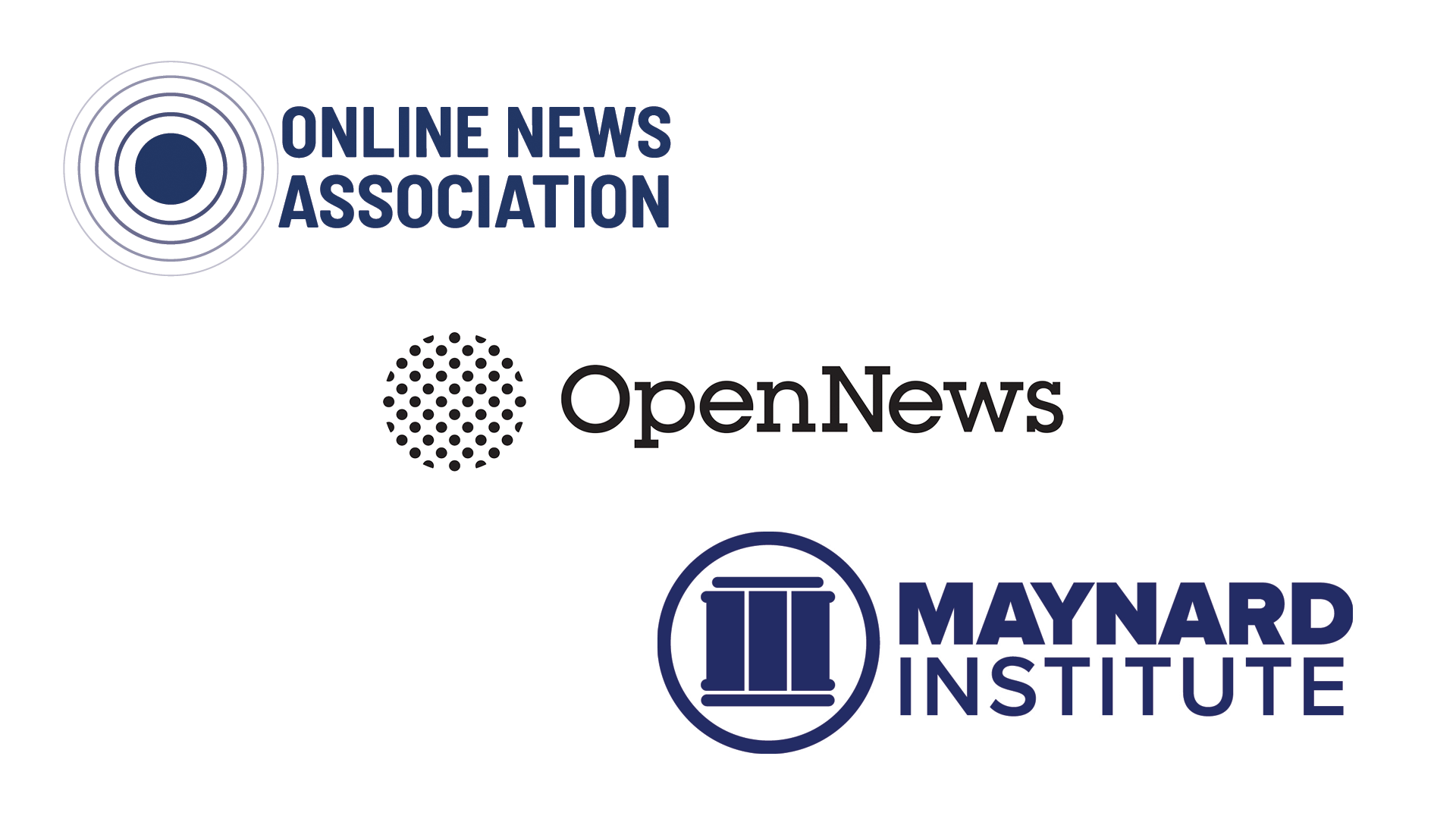
The Online News Association, the Maynard Institute for Journalism Education and OpenNews are committed to dismantling systemic racism in the journalism industry and transforming news organizations into institutions of belonging.
The past few months, we have worked behind the scenes scheming (the good kind) and strategizing new efforts through our Vision25 collaboration. We’ve convened newsroom leaders, spoken to funders and even brought together many of the people who were newly minted in their news organizations to address diversity, equity and belonging.
The conversations have been robust, revealing and troubling. In April, we’ll share some of what we’ve learned, including how the concept of belonging emerged as the aspiration we are pushing to see operationalized across the news industry.
Meanwhile, we’d like to share with you five opportunities to participate in Vision25 this month—through a fellowship, an event, a coalition, and resources to ensure information equity. And there is more to come.
Maynard 200 Fellowship Program: Apply by March 5
The Maynard 200 Fellowship is the Maynard Institute’s signature professional development program for media professionals of color. The fellowship provides cutting-edge training and year-long mentorship for leaders, storytellers and media entrepreneurs of diverse backgrounds guided by the expertise of a distinguished faculty across relevant disciplines. The program supports and emboldens the next generation of leaders, creators and founders of new media ventures. Diverse media executives advance belonging in their newsrooms, thereby advancing the goals of Vision25.
Apply to the Maynard 200 Fellowship by March 5
Maynard 200 Application Form
Maynard Institute’s Belonging in News series
The third episode of Belonging in the News is coming up on Wednesday, March 10 at 3 p.m. EST / 12 p.m. PST. Martin G. Reynolds, event moderator and co-executive director of the Maynard Institute, will discuss institutions of belonging with Pulitzer Prize-winning journalist, author and correspondent for CBS News, Wesley Lowery. In addition to discussing his experience investigating police shootings for The Washington Post’s “Fatal Force” project, we will discuss his own journey to find belonging as a journalist.
Register to join the conversation
OpenNews is launching the DEI Coalition For Anti-Racist, Equitable, And Just Newsrooms
Over 100 community volunteers have worked to create a digital community space dedicated to learning and taking concrete actions to create newsrooms and workplaces that are anti-racist, equitable and just. The space will serve as a place to work in solidarity across all levels of experience, on challenges members face in moving DEI forward in their newsrooms, and collectively creating strategies and resources to tackle those challenges. The development of this space has embodied the values of belonging that Vision25 is all about: OpenNews has intentionally designed the space with community leaders and members as a collaborative process. You can sign up to receive a notification when the community space, hosted on Slack, opens later this March.
Get notified when the DEI coalition community space opens soon
The Online News Association’s resource database for information access equity
The #ONAinfoequity database provides resources for journalists to engage communities that are historically under- or misrepresented in the media and ensure equitable access to information. Free Press’ Vanessa Maria Graber and ONA Board member Anita Li led over a dozen journalists to collaborate on this project through an ONA Community Circle. It’s a one-stop shop with guidance for identifying gaps in information access, making the case for community engagement to newsroom leadership and discovering ways to improve existing efforts.
Explore and share the #ONAinfoequity database
Support Vision25
Vision25 is a commitment by our three organizations to advance racial equity in journalism. But, to make this a reality, we need to do this together as an industry. If you’re interested in exploring funding or supporting this work, please email Irving Washington at irving@journalists.org to set up a conversation about our plans and how you can help.
Read an excerpt of the essay written by the Maynard Institute's Co-Executive Director, Martin G. Reynolds, for the…
The prize is awarded to the best journalism in the country that advances the understanding of stories and…
Read the letter from the Asian American Journalists Association, the Indigenous Journalists Association, the National Association of Black…
Five opportunities to connect with us.